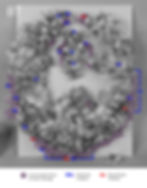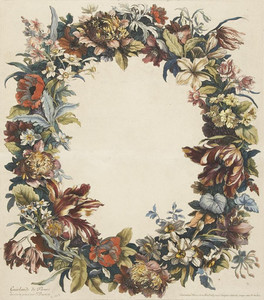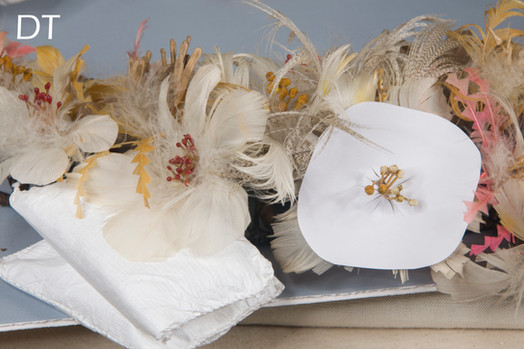Funerary Featherwork: Conservation of an American Feather Wreath
- Heather White, Objects Conservator
- Sep 5, 2020
- 14 min read
Updated: Sep 11, 2020

During Treatment (2020.001a)
At the workbench today is an American mourning wreath and two corsage elements constructed of feathers. It dates to the early 1930s and was created for a beloved resident of the Village of Marine, Illinois, and later donated to the Marine Historical Society.

Feather wreath and corsages before treatment (2020.001a_c).

Detail of lower wreath that was submerged in the water event, before treatment (2020.001a_c).
Unfortunately, the wreath came to us following a damaging water event, after intense rainfall caused a sewage drain to back-up and flood the basement where it was stored. While mounted inside its shadowbox on the floor, the lower half of the wreath was submerged.
Preventive strategies in storage go a long way towards preserving your items of value. If you're forced to store pieces in a basement, a good rule of thumb is to keep objects at least 4-6 inches off the floor, such as on blocks or a storage rack.
What are Feather Wreaths?
Cultural heritage material takes many forms, and a large part of every culture’s heritage are items related to their mortuary cult and traditions. But I admit that my knowledge of past American funerary traditions is rather thin, so the notion of a feather wreath was a new one for me….and I loved learning something new!
As always, I began by doing some research, trying to learn what I can about this type of object — interested, of course, in seeing what others have dealt with in treating these, but even more so in learning its context and cultural significance so my decisions in treatment remain as respectful and ethical as possible. Unfortunately, there seems to be a dearth of information on either front.
Most people are likely familiar with funeral wreaths. In fact, wreaths have a fascinatingly complex history as a symbol used to communicate joy, celebration, victory, life, death, afterlife, and mourning. The choice of flowers and foliage assembling the wreath is its own language, and gives it added layers of meaning. For instance, evergreens for Christians represent the triumph of the immortal soul over death, and white flowers like lilies can express the deceased’s purity, symbolize the restored innocence of their soul, and give hope for a return to happiness.
Ancient Greek and Roman cultures wore wreaths as a type of diadem or crown to indicate their status or position. Christians began hanging them on doors to invite the spirit of Christmas. In Victorian culture, a wreath on a door was a sign of public mourning; it announced that there’s been a death, the family was grieving, and to kindly leave them alone during this time. The image of a wreath today is somewhat distanced from its more distressing associations, though as an indelible symbol of eternal life in many religions, its presence in memorials seems likely to endure.
Feather wreaths were part of a “mourning wreath” craft tradition that arose in the Victorian Era (mid- to late-19th century), a period known for its particular fixation on the macabre. Other crafts included jewelry (“mourning jewelry”), corsages, cross-stitchings, and dried flower arrangements. The creation of such items were intimate expressions of mourning and commemoration made by loved ones, and the materials themselves were often physically linked to the deceased and their family. Most notoriously, the deceased’s hair or the hair from family members was incorporated into jewelry or woven into flowers to form wreaths. These creations were keepsakes and kept close, either worn or displayed in the home.
Examples of mourning jewelry and mourning wreaths made from human hair.
Feather wreaths were a later incarnation of this tradition which obviously persisted several decades into the 20th century. This object comes with an anecdotal origin story that says the feathers were taken from the deceased’s pillow, who died in 1933. I’d like to say I trust in the oral tradition that accompanies it, but my study of the object leaves me skeptical. Though compelling and in keeping with the nature of items from this mourning culture, this detail remains unconfirmed. Regardless, one way or another, the feathers are intimately connected to the deceased, even if that means they were simply chosen with care from a catalog by the deceased’s loved ones to include in this tribute.
Comparison feather wreath. Image Source: The Harp Gallery
Comparison feather wreath. Image Source: Sturgis Antiques
As with other mourning wreaths, this wreath was mounted and displayed in a shadowbox. Comparisons I’ve found show many walnut-framed shadowboxes with simple interiors, however there are also many displayed as this wreath: with ornate, gold-gilded frames and shadowbox interiors designed to imitate the inside of a casket. I found this particularly fascinating. Such a presentation deliberately emphasizes the death of this soul, who’s embodied in the expression of the wreath. A reminder to reflect on mortality; a heavily emphasized requisite of religious culture at the time.

Display of mourning wreaths made from hair at Leila’s Hair Museum, located in Independence, MO. Image Source: Culture Owl
The owners chose to not proceed with treating the shadowbox and frame—also quite damaged by the water event (2020.002a_b).
Since material choice was so significant in this practice, and intimately connected to the deceased, I found myself speculating as to whether the wood of the box came from the deceased’s home, the exterior wallpaper from the deceased’s bedroom, and the interior lining from her bedding.
Today, we’ve continued in the craft of wreath-making, but most often to create something celebratory and festive for the holidays or the seasons. It is no longer an exercise in grief or a contemplation of mortality. Our mourning customs have changed as our culture has. Wreaths are still included in our funerary cult, but the act of making them ourselves is not part of our process in dealing with the death or expressing our feelings over the loss. Nor do we endeavor to keep funeral wreaths on permanent display in our homes.
Pouring ourselves into crafts and projects no doubt still plays a significant role for many of us in coping with loss; laborious or artistic expressions of grief remain a part of our process. Though this particular practice of mourning wreaths and other mourning crafts — once expected and accepted — would easily be viewed as morbid through our 2020 lens. I always find it incredible how we continue to be an echo of our ancestors, and yet, after less than a century, can be so far removed from their mind-sets and customs.
Materials and Construction

View of top corsage element (2020.001b) before treatment.
It’s really no wonder why floral mourning wreaths were made from keratinaceous materials like hair and feathers. True flowers would decay, but flowers made from hair or feathers (wool was used as well) would stay frozen in time and resist deterioration, at least, for the foreseeable future.
The wreath and corsages are constructed of several individual imitation “flowers” tied together at their stems using various threads. The attachments are a bit precarious and the structures on a whole are quite flimsy. The items were attached to support boards using monofilament cord to allow for safe handling during treatment.
Each flower has a long stem composed of wires bundled together and wrapped in brown paper. There’s some type of glue or gum-like binder present over the paper, or the paper may be waxed. It seems likely that the same wires in the stems continue upward and exit as the imitation “stamen” at flower centers.

Backside of top corsage element (2020.001b) before treatment.

View of the wreath structure (2020.001a).
There are a variety of stamen tips in different colors and shapes. Some tips are long, some have tear-drop shapes, others are large spheres with granular surfaces, and many are small and bead-like — all atop stems of wire covered in waxed paper. Tips are of varying material with different water sensitivities based on their responses to prolonged submersion in the water event. All experienced different degrees of disintegration. Tear-drop tips were the least affected and seem to be a sort of hardened clay, but small, red-beaded tips were uniquely water-sensitive, leaving behind only stems with pink tops.
Colors too were water-soluble and completely dissolved, bleeding onto nearby feathers. But stamen color remained intact at the top of the wreath, and include bright reds, oranges, yellows, and browns with a notable gloss or sheen.
Details of the wreath (2020.001a), showing the variety of stamen.
Feather attachment is not entirely visible, however it appears feathers are embedded within a hardened, resinous glue at flower centers around the stamen; the material is dark brown though somewhat amber in color, and very glossy.
Flower “petals” are primarily pennaceous sections of contour feathers, though some of the more modified ones seem likely to be secondary wing or tail feathers. Plumulaceous downy feathers are at every flower’s center. In my study during treatment, I found some of the calami of the plumulaceous feathers that missed gluing to be curled tightly in a spring-like fashion around stamen. By the end of treatment, I was convinced many of these "downy" feathers were actually the proximal plumulaceous sections of the same contour feathers whose distal ends form the flower petals.
Feather Identification and Modification
Feathers have a very rich history in different decorative arts and traditions over the centuries, and feather identification can provide important insights into cultural decisions that went into making an object. However, identification is especially difficult here since every feather has been significantly modified.
Feathers are often decoratively modified when they’re employed in cultural objects, and there’s no exception in this mourning wreath. Every feather received modification, and each bundled with others to create a variety of different “flowers”. Given the significance of flower choice in wreaths, some bundles certainly look inspired by specific flowers to me — perhaps lilies, gladioli or daffodils — but other flowers are also clearly fanciful imaginings.
All feathers have pointed or blunt-cut tips, and many have different serrated edges to modify their shape. In addition, curling was employed a lot, which is a modification produced similarly to curling a ribbon: the edge of the feather is pinned against the hard, blunt edge of a tool using one’s thumb, and that tool is “scraped” against the feather as one pulls away in a sharp motion.
The most eye-catching feathers are ones artificially colored pink and yellowish-orange. Though now largely faded by light damage, the original vibrance of these colors has remained intact on the backsides of the wreath and corsages in areas protected from light exposure.

View of the upper wreath and corsage before treatment (2020.001a_b), detailing the different flower bundles and feather modifications.
Light damage refers to the photochemical effects of radiant energy, specifically ultraviolet energy, which is deleterious to feathers’ keratin structures, as well as leads to the loss of both natural and artificial feather coloration. As an object created for long-term display, cumulative damages from light exposure have notably impacted its condition.
Since I'm no ornithologist, I can only venture a guess into identifying the species’ sourced for the wreath’s feathers. Fortunately, there are some valuable resources online that can aid in identification, including the U.S. Fish and Wildlife’s Feather Atlas.
I’d say that plain white feathers — the most prevalent in the constructions — came from common goose or chicken species. Fault bars were noted on many of these: weakened areas that indicate the birds experienced periods in their life of notable stress or inadequate nutrition.
In addition to plain white, there are 3 feather types with natural pigmentation and patterns that make identification more possible. The first is a black contour feather with a pattern of small white spots used strikingly in two bundles at the very top of the wreath. These belong to an African species of guineafowl, likely the Helmeted Guineafowl (Numida meleagris), a widely distributed domesticated game bird brought to the United States by early settlers.
Next is a a silver/white colored feather with a speckled brown pattern used throughout different bundles on either side of the wreath, which looks to belong to a duck or partridge, possibly the Hungarian Partridge (Perdix perdix). Another popular game bird, the Hungarian Partridge (or grey partridge) was introduced to the United States in the 19th century, but a huge importation came from Europe around 1908/9.
And last is a white-tipped, warm-brown pennaceous feather used in a few bundles opposite each other at the curve of the wreath. I had more difficulty identifying these, but they seem to match secondary wing feathers from a female King Eider duck (Somateria spectabilis). However, these are coastal birds, so their inclusion in a wreath from Illinois would be most interesting, and would lead me to think some of the feathers or bundles sold for mourning wreaths came in from coastal domestic suppliers.
Solvent Cleaning and Grooming
The entire wreath had an accumulation of dark soot in addition to being contaminated with debris and sewage from the water event that submerged it. Soiling was a tenacious, thick residue over many feathers, sometimes having a greasy nature. Feathers were tangled and plastered together, held by dried debris and residue from dissolved stamen tips. Feather shapes were distorted and their surfaces obscured.
Wreaths are made to communicate, and their flowers and colors play key parts in their message. This made the wreath’s current condition particularly disfiguring, and made treatment, and a return to its prior state, more meaningful.
Testing determined isopropanol to be most effective at loosening dried debris, releasing plastered feathers, and removing soiling. It also proved least disturbing to artificially applied color, though these feathers were largely avoided. Availability of isopropanol was affected by the coronavirus pandemic — at its height during this time — and both over-the-counter 91% isopropanol and laboratory grade 99% isopropanol with deionized water dilutions were utilized in the course of treatment.
Given the manner in which feathers were attached and overlapped, cleaning was tricky and somewhat limited. Still, each feather received attention as was safely possible.
Treatment in progress as the wreath (2020.001a) reached a mid-way point in solvent cleaning.
When working with private owners and non-profits operating on a limited budget, it’s important for me to find the most economic routes to treatment that don’t sacrifice standards or quality of work. Conservators have explored many readily-available materials for cleaning featherwork, such as cosmetic polyurethane sponges, cosmetic cotton compresses, and store brand rubbing alcohol.
For this treatment, use of quickly-disposable paper towel squares (undyed) and cotton swabs proved most affordable for the client, most available to me, and most favorable given the contamination and condition issues afflicting the wreath.
Each feather was carefully supported and isolated for cleaning. Cotton swabs holding solvent were gently guided over upward-facing dorsal sides in the direction of the vane. The isopropanol flowed through the barbs, carrying soiling to a piece of absorbent paper towel held behind the feather over a rigid blueboard support. Large, loose swabs meant more solvent and minimal, gentle contact over the barbs, which are easily disturbed by pressure.
Example of cleaning progression for an individual feather with greasy soiling at the top of the wreath (2020.001a). Not shown are 5-6 replacements of dirtied paper towel before the feather reached its final, cleaned state.
The use of cotton swabs was especially effective at agitating and lifting intractable soiling and debris from dorsal surfaces, as well as catching debris from ventral sides.
Using paper towels in this manner was a novelty for me and experimental, explored as an option to reduce the cost of treatment, however there were unexpected advantages. They were extremely adaptable, able to be quickly wrapped around and secured to any size/shape of blueboard support needing to fit behind the tightly overlapped feathers. They were also of limitless and accessible supply — a huge asset during COVID-19 quarantine.
Naturally, squares became saturated with dirty solvent quickly and required frequent replacing. However, since their limited performance necessitated frequent disposing, they actually worked quite well from a health and safety perspective. Contaminated paper towel squares were swapped out for new ones up to 10 times in the course of cleaning some of the filthier feathers, and exchanging these became as quick and deft-of-hand as replacing swabs.

Example of a spent square of paper towel before replacement.
After air-drying, plumulaceous feathers were gently fluffed using a clean, natural-bristle brush. For pennaceous feathers, reshaping and grooming largely occurred while wetted with solvent. Barbs were realigned and barbules re-hooked using gloved fingertips, aided by a brush or skewer. Some of the curled feathers straightened during cleaning, so these were re-curled using the blunt edge of a micro spatula in the method described previously.
Being that the piece had been contaminated by sewage for several hours, nitrile gloves were worn at all times during treatment, along with other precautionary measures in treatment and storage. In fact, it’s safest to always assume feather objects are contaminated in some manner, as it was common practice for them to be treated with hazardous substances in the past — arsenic, mercury, bromides, naphthalene, etc. — in a preservation effort to deter pests.
Insect Damages and Feather Mending
The trauma of the water event and a past insect infestation resulted in bent/broken shafts, detached feathers, and barb losses from vanes. Based on the larval casings, these were a species of carpet beetle (Anthrenus genus, Dermestidae family), a common heritage-eater that feeds on keratin — plenty of yummy proteins, lipids, and biopigments for larvae to consume.
Examples of detached feathers. The bottom of the wreath, especially, had piles of detached, loose feathers.

Insect casings were located deep within bundles, at the base of stamen and plumulaceous feathers, and activity was concentrated on bundles that circled the lower, outer perimeter of the wreath. These areas were most obscured from view/hidden from light, where activity could occur undetected.
View of larval casings lined-up at the center of a flower within plumulaceous feathers, and a transmitted light micrograph of one of the casings. Several dozen casings were removed from the constructions.
Detached feathers were collected, cleaned and reintegrated using a splinting method where a tiny splint was adhered over the dorsal side of the feather, bridging the two halves of the broken shaft. Bent feathers received structural splints as well to provide necessary support, applied to the indented side of shafts. In this case, splints were portions of cuticle cut from the calami of unprocessed chicken feathers of no connection to the piece, which were ethically and legally sourced. Care was taken to create the splint from either a clear or appropriated-pigmented portion of the cuticle — whatever blended best with the feather being mended.

Pile of cleaned, detached feathers and splints (on left) awaiting reintegration.
Slideshow showing the process of cutting a small portion of calamus cuticle, adhering it to the shaft of a detached feather with a dab of concentrated Paraloid B-72, and then joining it to the receiving end of the broken shaft within the bundle.
It’s important to stress the protective legislation in place concerning possession and sale of native North American bird feathers (and other bird parts). It may sound barmy that you can be fined several thousands of dollars and sent to jail for taking home that Mourning Dove feather you found outside, but the Migratory Bird Treaty Act (MBTA) works to ensure that countless native species are never again hunted to endangerment by people desiring to possess or adorn themselves with particular feathers. Learn more!
Reconstructing and Inpainting Flower Stamen
The imitation flower stamen were greatly impacted by the water event, dissolving to various degrees. All tips were given a couple drops of ~3-5% w/v Paraloid B-72 in acetone delivered via pipette: a protective coating for intact tips at the top of the wreath, and a consolidative, isolating layer on damaged tips before inpainting.
The loss of color on damaged stamen tips resulted in a distinct washed-out appearance for the lower half of the wreath. Without the contrast of those central elements, the flowers were difficult to distinguish and made the wreath visually divided, so it was decided to tone these. Intact tips were able to inform their intended color.

View of the wreath (2020.001a) after cleaning, prior to inpainting, showing the visual disconnect between stamen with intact color at the top of the wreath, and stamen that have lost color on the lower wreath.
Each bundle of stamen were isolated for consolidation and inpainting using a scored piece of paper. Cotton packed below the paper was an added measure to protect plumulaceous feathers from consolidant drips. Colors were matched and inpainted using QOR watercolors. Paper was easily torn and pulled away after stamen had dried.
Views of stamen isolated during inpainting.
Small, red-beaded tips needed to be reconstructed before inpainting, as they completely dissolved in the water event. These were created by using concentrated B-72 in acetone bulked with fumed silica; each rolled, shaped and applied to stems using fingertips and small tools.

View of stamen on the lower corsage (2020.001c) showing the reconstruction of small, red-beaded tips and inpainting.
Water-soluble inpainting was given a protective coat of B-72, and shine from the coating was matted or adjusted as necessary.


Details of the wreath before and after inpainting.
Returning color to the damaged stamen significantly improved the legibility of each individual flower in the constructions.
Final Results


Recommended Resources
The American Museum of Natural History, Natural Science Conservation Lab blog, In Their True Colors. Available at: https://intheirtruecolors.wordpress.com/
The Cornell Lab, Bird Academy. Available at: https://academy.allaboutbirds.org/
Drummond, G. 1994. “The Mending of Feather Vanes,” AICCM Bulletin 19(3-4): 39-59.
Dzikiewicz, K. 2018. “Conservation Topics: Why Your Bird Feather Collection Might Be Illegal, Storage Room No. 2: Musings From The Bruce Museum Science Department, June 4. Available at: http://www.storagetwo.com/blog/2018/6/why-your-bird-feather-collection-might-be-illegal#:~:text=When%20it%20was%20enacted%2C%20the,you're%20breaking%20the%20law
Fornicello N. 2010. “An Effective Method for Cleaning Feather Bonnets,” The Ethnographic Conservation Newsletter of the Working Group on Ethnographic Materials of the ICOM-CC 31: 5-8.
Langford, D. 2014. “The Etiquette of Mourning,” A Truly Victorian Experience: Tinker Swiss Cottage Museum’s Blog, August 21. Available at: https://tinkercottagemuseum.wordpress.com/2014/09/30/the-etiquette-of-mourning/
Moreki, JC. Unknown Year. Guinea Fowl Production. Available at: https://web.archive.org/web/20150701172947/http://www.gov.bw/Global/MOA/Guinea%20Fowl%20Production.pdf
Pearlstein, E. (ed) 2017. The Conservation of Featherwork from Central and South America, London: Archetype Publications Ltd.
Philips, J. C. 1928. Wild Birds Introduced or Transplanted in North America, United States Department of Agriculture, Technical Bulletin No. 61. Available at: https://digitalcommons.unl.edu/cgi/viewcontent.cgi?article=1824&context=usdaarsfacpub
US Fish and Wildlife Service, Forensic Laboratory, The Feather Atlas. Available at: https://www.fws.gov/lab/featheratlas/
US Fish and Wildlife Service, Migratory Bird Treaty Act. Available at: https://www.fws.gov/birds/policies-and-regulations/laws-legislations/migratory-bird-treaty-act.php
Please, do not attempt any treatments disclosed here if you are not a conservation professional.
Content is not a how-to guide, and all decisions are unique to the circumstance, and informed by years of training, experience, and accreditation.
Digging the behind-the-scenes experience?
More case studies are available on our Portfolio Page!















































































































